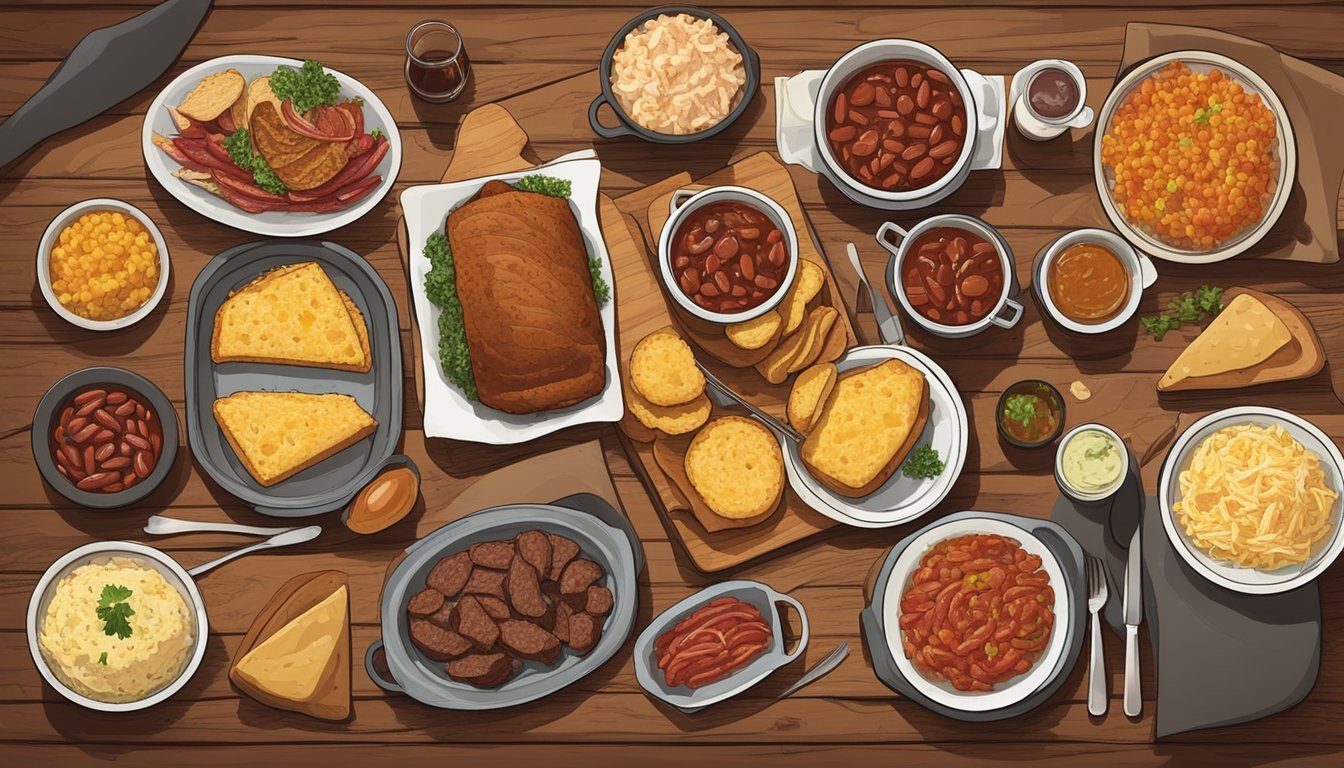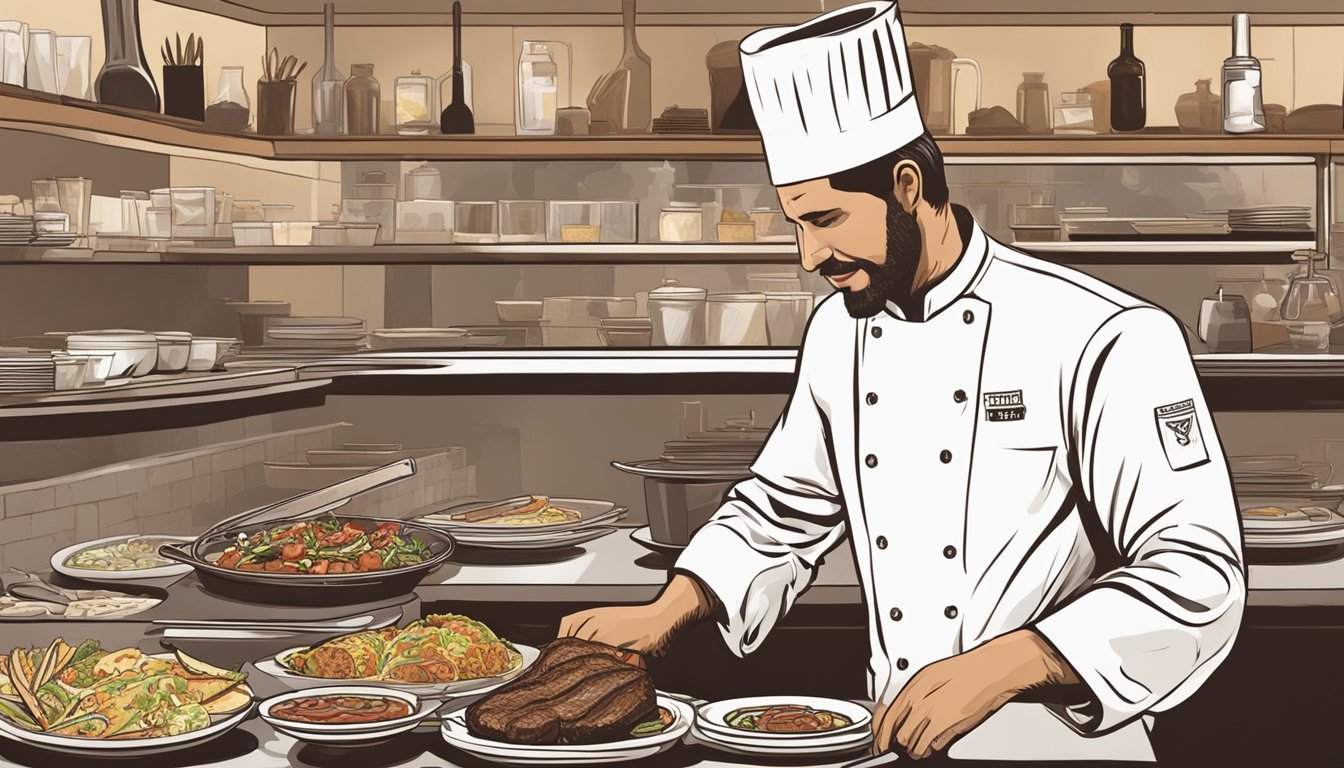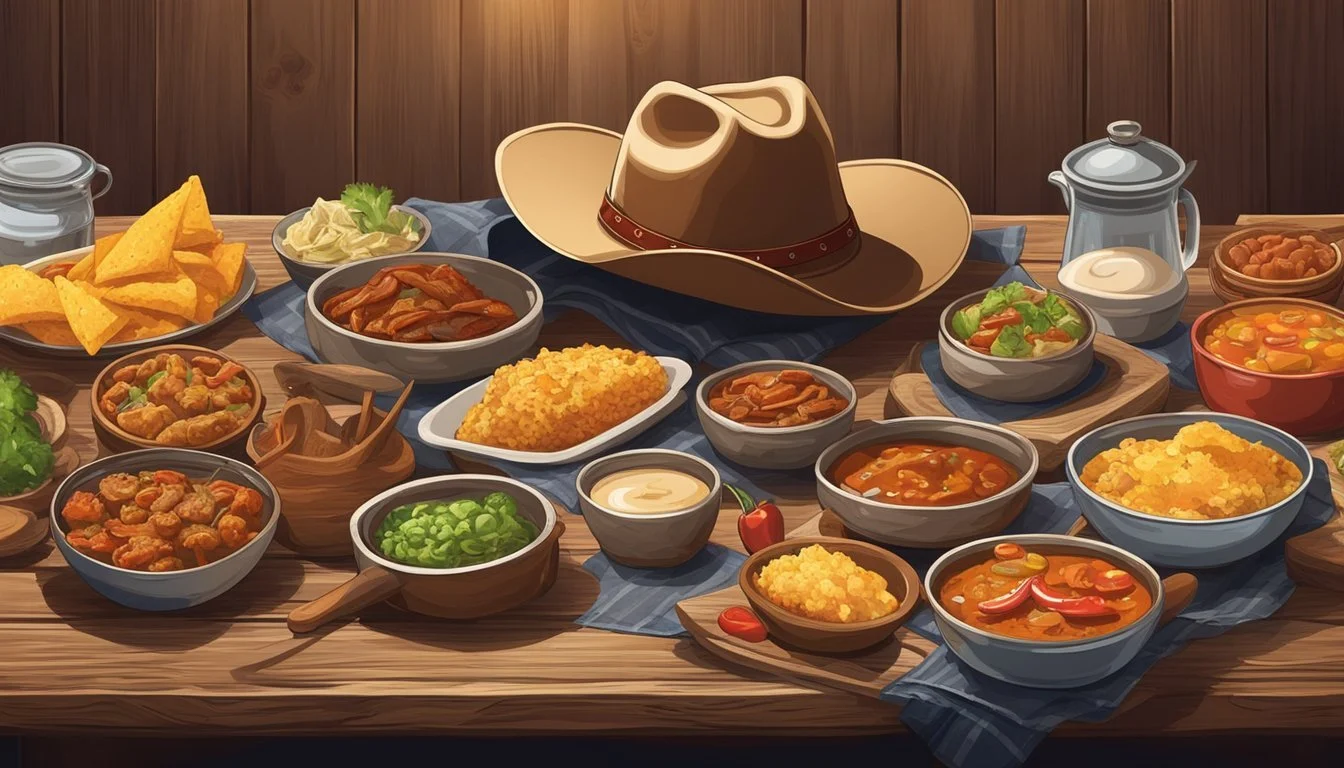Exploring the Diversity of Texan Cowboy Cuisine
A Culinary Adventure
Texan cuisine is a vibrant testament to the state's cultural heritage, where the traditional cowboy fare speaks volumes about the people and history of Texas. This unique culinary tradition stems from a fusion of Mexican, Native American, and European influences, crafting a flavor profile steeped in the rich tapestry of the state's diverse backgrounds. At the heart of cowboy cuisine lie simple yet hearty ingredients — beef, beans, corn, and chili peppers, combined with bold spices that give rise to the bold dishes synonymous with the rugged cowboy lifestyle.
The cowboy of the American West imprinted an indelible mark on Texas's culinary and cultural landscape. The chuckwagon, the mobile kitchen of the open plains, became a symbol of Texas ingenuity, creating meals that fueled cowhands and travelers alike. These mobile feasts were not merely about sustenance but were gatherings that celebrated the spirit of togetherness and resilience in the face of the harsh realities of ranch life.
Today’s Texan cuisine embraces its roots while evolutionizing to match the contemporary palate, forging a distinct path that honors tradition without forsaking innovation. From the smoky pits of barbecue (What wine goes well with barbecue?) mastery to modern interpretations of classic dishes, the essence of cowboy cooking remains, adapted for today's diverse and discerning diners. In exploring the diversity of Texan cowboy cuisine, one finds a culinary tradition that reflects the state’s proud history and the spirit of its people, perpetually bridging the past with the present.
Historical Roots of Texan Cowboy Cuisine
The evolution of Texan cowboy cuisine is a tapestry of cultural influences and practical adaptations born of necessity on the range. This rich culinary tradition reflects the state's history and the diverse peoples who have shaped it.
Influence of Early Settlers and Immigrants
Texan cowboy cuisine has its beginnings in the intersection of various cultures. Early Spanish settlers brought with them their livestock and cooking techniques, profoundly shaping the diet of future Texans. Over time, immigrants including the French, Czech, and German communities introduced their culinary traditions to the region. They contributed pastries, sausages, and breads, which were incorporated into the local diet, sometimes adapting to the ingredients and cooking methods available on the range.
Evolution from Open Range to Chuckwagon
The iconic chuckwagon was an innovative response to the needs of ranchers and cowboys during extended cattle drives. Prior to chuckwagons, cowboys often subsisted on dried or easily preserved foods. However, with the advent of the chuckwagon, cowboys were provided with fresh, hearty meals cooked over open fires. Ingredients like beans, coffee, and sourdough became staples, providing the necessary sustenance for the rigorous demands of cattle herding.
Legacy of the Vaqueros
Vaqueros, the skilled horsemen and herdsmen of Hispanic origin, are the forebears of the Texan cowboy. These early cowboys greatly influenced ranching practices as well as the burgeoning cowboy culture—including its cuisine. The vaqueros contributed techniques of barbecuing meats and making Tex-Mex staples like tortillas and various salsas, which remain cornerstones of Texas fare. They harmonized their native cooking with local ingredients, blending Native American and Spanish flavors to create the foundational elements of what is today recognized as Texan cowboy cuisine.
Foundational Dishes and Ingredients
The diversity of Texan cowboy cuisine is built upon a foundation of key ingredients such as beef, corn, and beans. These staples are used in a variety of dishes that are rich in flavor and tradition.
The Role of Beef and Barbecue
Beef is the cornerstone of Texan cowboy cuisine, with barbecue being a celebrated method of preparation. These practices emerged out of necessity, providing a way to preserve meat before the advent of refrigeration. Barbecue in Texas goes beyond mere cooking; it is a craft honed over generations, featuring cuts like brisket and ribs that are slow-cooked to perfection. Chili, another dish central to cowboy culture, usually incorporates beef as its main protein, seasoned with a blend of spices.
Corn and Its Central Role
Corn has historically been a crucial crop in Texas, utilized in many forms across cowboy fare. Cornbread and tamales are prime examples of corn's versatility. Cornbread, often served alongside chili, provides a sweet and crumbly counterpoint to spicy dishes. Tamales, on the other hand, consist of a corn-based dough filled with seasoned meats or beans, wrapped in corn husks and steamed—a reflection of the fusion between Native American and Mexican culinary traditions.
Variety in Beans and Legumes
Beans serve as an important source of nutrition and have long been a staple in the cowboy diet. They appear in various traditional dishes, from pinto beans cooked over an open fire to black or kidney beans found in chili recipes. Beans are valued for their high protein content, versatility, and ability to be stored easily, making them an ideal component for the life of a cowboy on the trail.
Cooking Techniques and Food Preparation
Texan cowboy cuisine is characterized by its inventive use of simple cooking techniques that could endorse the rugged outdoor conditions, transforming basic ingredients into hearty meals.
The Tradition of Chuckwagon Cooking
Chuckwagon cooking originated with the invention of the chuckwagon by Charles Goodnight in the 1860s. It was a mobile kitchen that followed cowboys on cattle drives, using campfires and coals to prepare meals. This form of cooking technique made ample use of what was accessible on the trail. The open fires were essential, allowing cowboys to cook over direct flames, imbuing the food with a distinctive smoky flavor.
Grilling and Smoking Meats
Texan cowboy cuisine is renowned for its methods of grilling and smoking meats. High-quality beef is often the centerpiece, slowly cooked over indirect heat to achieve the perfect tenderness and smokiness. Smoked sausage and other meats are treated as staples, with the smoke from hardwoods like mesquite and hickory serving as a natural seasoning.
Techniques used:
Direct grilling for steaks and chops
Indirect smoking for briskets and sausages
Use of Dutch Ovens and Skillets
Versatility in cowboy cuisine is showcased through the use of Dutch ovens and skillets. These robust pieces of cookware are adept at cooking over open flames and can be buried in coals for even heat distribution. Dutch ovens were particularly favored for making stews and bread, while skillets proved ideal for frying and sautéing a variety of ingredients.
Cookware preferences:
Dutch Ovens: for stews, chili, and baking bread
Cast-Iron Skillets: for frying eggs, bacon, and potatoes
Unique Flavors and Spices of Texas
The diverse culinary landscape of Texas is marked by bold flavors and distinctive spices that define its cowboy cuisine.
The Heat From Chili Peppers
Chili peppers are a cornerstone of Texan cowboy cuisine, offering heat and depth to many dishes. The use of jalapeños and other hot peppers is prevalent, imparting a zesty flavor to chili con carne, a staple of the Texan diet.
Commonly used chili peppers:
Jalapeños
Serrano
Habanero
These peppers are often used fresh, roasted, or smoked, providing a range of flavors from mild to intensely hot.
Tex-Mex Signature: Cumin
Cumin is a signature spice in the Tex-Mex palette, notable for its earthy, warm flavor. As a fundamental ingredient, it gives a distinctive taste to fajitas and enchiladas, making these dishes quintessentially Texan.
Typical dishes featuring cumin:
Fajitas
Enchiladas
Tex-Mex beans
Cumin's persistent presence in these recipes showcases its adaptability and importance in defining the state's cuisine.
Influence of Sweet and Sour
The interplay of sweet and sour elements is essential in balancing the robust flavors of Texas cooking. The use of mustard and pickle is a testament to this balance, contrasting with the spiciness of chili peppers and the earthiness of cumin.
Sweet and sour components:
Mustard (usually a tangy Dijon or a classic yellow)
Pickles (dill or sweet)
These ingredients often accompany meats or are included in sauces, providing a complementary tang that enriches the overall dish.
Texan Cuisine in Modern Times
While Texas is historically known for its cowboy culture, today's Texan cuisine reflects a rich tapestry of regional flavors and a dynamic fusion of globally-influenced culinary practices. This evolution continues to play a pivotal role in defining the state's gastronomic identity.
Modern Fusion and Tex-Mex Evolution
The integration of Tex-Mex with modern culinary trends illustrates the progressive nature of Texan cuisine. Restaurants in cities like San Antonio and Houston have pioneered innovative dishes that blend Southwest flavors with global influences. Tex-Mex, initially a regional fork of Mexican cuisine, has become a genre-spanning powerhouse with dishes such as barbacoa gaining widespread recognition. Ingredients and methods from different cultural backgrounds are strategically incorporated to create new Texan classics.
Cuisine Variations Across Texas Regions
Texas's vast geography cultivates distinct culinary traditions in its various regions. Central Texas is renowned for barbecue that leans heavily on Czech and German influences, utilizing dry rubs and slow-smoked meats (What wine goes well with smoked meats?). On the other hand, East Texas cuisine features a distinctly Southern style with an emphasis on marination and moist cooking techniques. The coastal city of Houston boasts a diverse array of seafood dishes (What wine goes well with seafood dishes?) that reflect its proximity to the Gulf.
Region Style Notable Techniques Central Texas Barbecue-centric Dry rub, Slow-smoking East Texas Southern cooking Marination, Moist cooking Houston Seafood and Global Fusion Multicultural approaches
Texan Cuisine in Contemporary Culture
Texan cuisine's allure extends beyond the plate into popular culture, casting a spotlight on the state's culinary heritage. Fredericksburg, known for its German immigrant roots, shows how deeply immigrant foodways are woven into the Texan food fabric. The city continues to honor its past while embracing modern tastes. Gastronomic adventures in Texas are often associated with attending food festivals, watching cooking shows, and dining at restaurants that showcase the state's ability to harmonize traditional roots with contemporary flair.
Signature Texan Cowboy Dishes
Texan cowboy cuisine captures the robust and hearty flavors synonymous with ranch life. The following dishes are central to this beloved regional fare.
Meats: Steaks, Brisket, and More
Texan cuisine is renowned for its high-quality meats, with steak holding a place of honor. Beef brisket, (What wine goes well with beef brisket?) slow-cooked to perfection, is another staple that showcases the importance of patience and skill in cowboy cooking. Chicken fried steak, a country classic, represents the unique Texan twist on southern comfort food, featuring a crispy, breaded beef cutlet served with rich gravy.
The Sweet Side: Desserts and Pastries
No Texan meal is complete without a nod to the state's celebrated sweets. Peach cobbler, with its luscious fruit filling and flaky crust, speaks to the rancher’s appreciation for seasonal ingredients. Furthermore, pecan pie, a treasured dessert, combines locally grown nuts in a sweet, syrupy filling, offering a true taste of Texan tradition.
Hearty Sides and Fixin's
Sides are not an afterthought in cowboy cuisine but rather pivotal components of the meal. Cowboy beans, often referred to as chuckwagon beans, boast a blend of pinto beans, ground beef, and smoked meat, heartily seasoned and cooked over an open flame. Meanwhile, chili con carne brings together tender beef chunks and chiles in a rich and flavor-packed stew. Fajitas, featuring grilled skirt steak or chicken served with sautéed peppers and onions, provide a communal dining experience true to the ranching culture.
Culinary Landmarks and Food Tourism
Texas's rich culinary heritage is showcased through its diverse array of barbecue joints, historical sites offering traditional foods, and scenic dining along the San Antonio River Walk. This section highlights must-visit landmarks and gastronomic events for food lovers keen on exploring the unique flavors of Texan cowboy cuisine.
Prominent BBQ Spots and Festivals
Texas Hill Country is renowned for its barbecue, with joints like Franklin Barbecue in Austin consistently drawing crowds for their slow-smoked brisket. Equally famous is Salt Lick BBQ near Driftwood, offering a rustic setting and pit-smoked meats that epitomize Hill Country's barbecue tradition. Travelers can immerse themselves in the state's barbecue culture at annual festivals such as the Lockhart BBQ Festival, which treats visitors to a wide variety of smoked meats and traditional sides.
Festival Name Location Notable Features Lockhart BBQ Festival Lockhart Large variety of smoked meats and sides
Historical Sites and Their Culinary Offerings
Visitors to The Alamo can extend their experience by exploring the nearby Briscoe Western Art Museum, which, in addition to its historical exhibits, occasionally hosts events featuring authentic cowboy cuisine. These venues provide insight into the food traditions that arose during Texas's storied past, while allowing guests to indulge in local fare reflective of the state's history.
San Antonio's River Walk Dining
The San Antonio River Walk not only boasts beautiful scenery but also a vibrant culinary scene. Diners can enjoy a range of Texan flavors as they stroll along the banks of the river, with options ranging from upscale restaurants to casual eateries. Boudro's is a must-visit for their table-side guacamole and zesty Tex-Mex cuisine, while The Esquire Tavern offers a historical ambiance with its pub-style food dating back to 1933.
Dining Spot Cuisine Specialty Boudro's Tex-Mex Table-side guacamole The Esquire Tavern Pub-style Historical ambiance dating to 1933
The Social Fabric: Events and Gatherings
In Texas, culinary traditions are celebrated and preserved through a variety of events and gatherings that showcase the state's rich cowboy culture and the fusion of Tex-Mex flavors. These events are central to the community spirit and offer a sensory experience into the state's heritage.
Rodeos and Chuckwagon Competitions
At rodeos throughout Texas, chuckwagon competitions offer a glimpse into the historical cowboy cuisine. These contests often feature teams that prepare traditional dishes using methods akin to those of cattle drives from the 19th century. Rodeos serve as grand stages where the likes of chili, biscuits, and stews are not just food but a part of the culinary journey and historical reenactment.
Community Celebrations and Tex-Mex Festivals
Tex-Mex festivals dot the calendar, illustrating the blend of Mexican cuisine with Texas-style cooking. These community celebrations are opportunities for locals and visitors alike to savor dishes like enchiladas, tamales, and barbacoa. Tex-Mex food, a term that came to prominence in the mid-20th century, reflects the state's diverse cultures and the creativity they inspire in the kitchen.
Family Gatherings and Traditions
Family gatherings in Texas are often centered around food, where recipes are passed down and new traditions are forged. Barbecues and outdoor cookouts feature prominently, offering a taste of Texas cuisine from smoked brisket to spicy sausages. These traditions reinforce the notion of food as a connective thread in the social fabric, with family recipes serving as heirlooms linking generations.








